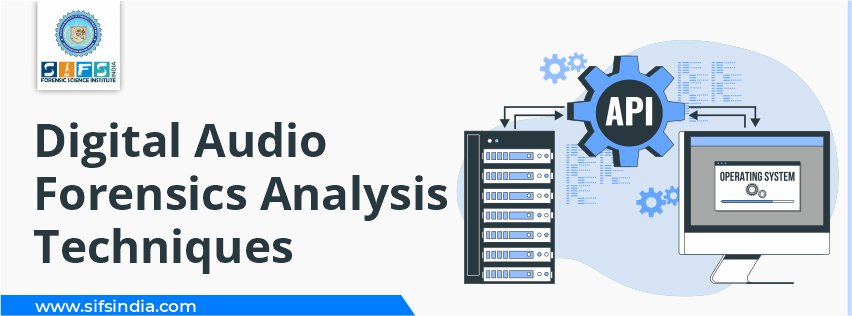- Call Us: +91 7303913002
- Email Us: education@sifs.in
Digital Audio Forensics Analysis Techniques

BY SIFS India | May 11, 2020
Digital Audio Forensics Analysis Techniques
Audio forensics is concerned with the scientific representation, analysis and evaluation of audio recordings that are obtained from a civil or a criminal legal proceeding and can be presented as physical evidence in a court of law or any other official venue.
The audio evidence can be presented in the court as physical evidence under section 65B, the section for the admissibility of electronic records.
Role of an Audio Forensic Examiner
The authenticity of the audio evidence should be verified before presenting it in the court of law otherwise the evidence will not be admissible. The audio forensic examiner plays an important role in determining the authenticity of the audio recording. After analysis, the examiner can interpret whether the recording is original or it has been being tempered.
Need for Audio Forensics
• To identify whether the recorded audio under question is tempered or not
• To enhance the quality of the speech in the audio
• To identify the speaker in the questioned audio
Audio Evidence in Investigation
Authenticity
The primary step for the analysis of an audio recording is to establish the authenticity of the recording. The forensic examiner verifies if any alteration such as addition, substitution or deletion has been made to the recording.
Enhancement
The quality of the audio evidence is not always good. Many times it is really difficult to recognize the speech in the recording due to the background noise and to resolve this issue, to understand what is being said, the enhancement of the audio recording is done.
Interpretation
After authentication and enhancement, the evaluation of the audio recording is done in order to understand and interpret the relevance of the audio to the investigation. It includes recognition of the speech (speech recognition), recognition of the speaker (speaker identification), and interpretation of background noise that can indicate the environment in which the audio was recorded.
Digital Audio Forensics Analysis Techniques
To authenticate the integrity of the digital evidence, different digital audio forensic techniques have been developed so that tampering with the audio evidence could be detected.
The audio verification techniques can be broadly classified into two types-
1. Container-based authentication
2. Content-based authentication
Container-Based Analysis
File Format: The brief description of the file with relevant information is stored for future reference.
MAC Time Stamps: It includes the detection of the date and time of creation and modification of the file.
Header: Any modification can be detected using any hexadecimal reader and header information of the file reader. If the file is authentic, the file name should match the file name extension. Device information can be available depending on the device and brand. Time stamps should be noted to compare them with the time claimed by the recordist.
Hex Data: Raw digital data of the file may carry useful information such as block addresses of audio, titles of external software (if present) and post-processing operations.
Content-Based Analysis
Electronic Network Frequency (ENF): It relies on the traces of ENF present in the audio. The abrupt changes in the power grid signal in the spectrogram visually identify that the audio has been tempered.
Time-frequency: The recording device also records other signals such as signatures which provides information regarding file ownership and the recording location.
Enhancement: Noise is deliberately added in the audio in such a way that it becomes a part of the recording and to reduce this unwanted noise that is present in the original audio and to enhance the quality of the speech in the audio without damaging the original information the audio enhancement is done.
Environment: Reflected signals, secondary sources and ambient noises in the evidentiary audio can be utilized to characterise the environment in which the audio was recorded. Background noise depends on the secondary source activities. The audio authentication and real-time crime identification can be done using Acoustic Environment Identification (AEI). Estimating reverberation and background noise can be used to calculate AEI.
Compression: The audio files are compressed and decompressed for malignant purposes. The file is compressed to recompress it at a higher bit to pass it as a high quality audio.
References:
Maher, Robert C. “Overview of Audio Forensics.” Studies in Computational Intelligence Intelligent Multimedia Analysis for Security Applications, 2010, pp. 127–144.Malik, Hafiz. “Acoustic Environment Identification and Its Applications to Audio Forensics.” IEEE Transactions on Information Forensics and Security, vol. 8, no. 11, 2013, pp. 1827–1837.
Zakariah, Mohammed, et al. “Digital Multimedia Audio Forensics: Past, Present and Future.” Multimedia Tools and Applications, vol. 77, no. 1, 2017, pp. 1009–1040.
Note- Sherlock Institute of Forensic Science India provides a great opportunity to Learn Forensic by attending different Forensic events being organized from time to time and also by registering yourself into Forensic Courses and Training Programs both online and offline mode. You can also visit our Youtube channel for all the events.
